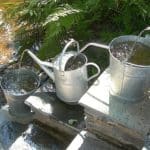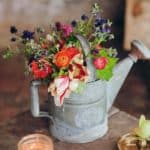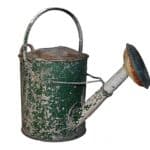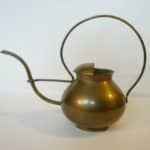Watering Cans Can
by Jessica Kosinski
Whenever the weather permits, many of us like to be out in the garden planting, weeding, and, of course, watering. Some people reach for the nearest hose to do that, but others prefer the tradition of using a watering can. This month we’re taking a peek at antique watering can styles, uses, decorating ideas, and values.
Watering Cans at a Glance
Watering cans today can be either practical, decorative, or both. However, they were originally designed for the practical purpose of watering crops and flowers. They have existed in some form for centuries, but the first known instance of them being called watering cans was in the 1690s. Prior to that, they were commonly known as watering pots.
Throughout history, watering cans have changed in size, shape, style, and material, but their general form has been fairly consistent. Each one usually has some sort of spout and either one or two handles. Earlier watering cans tend to be quite basic, while those from more recent history can include elaborate designs and, in some cases, vibrant colors.
If you plan to collect watering cans then your first clue as to the origin of a can may be its general style. For instance, early American watering cans were made of metal and had practical, somewhat bulky shapes. They were clearly built to perform a task and last for a long time.
French watering cans, on the other hand, often have single elaborate handles that arch upward above the top of the can itself. Some of them look almost like large single-handed pitchers. While they still work for all practical purposes, they also show a sense of style and elegance that is very different from their American counterparts.
Of course, other countries also developed their own unique watering can styles. For example, some English watering cans have two handles, while many American and French cans only have one. One famous English example is the Haws watering can, which was patented in 1886. It features one handle on top for carrying the watering can and one in the back for pouring the water. The Haws company still exists today, and it specializes in producing many different types of watering cans. Most of today’s Haws watering cans have kept parts of that original patented design.
Reasons to Collect Watering Cans
One reason to collect watering cans is to use them in your garden. Any serious gardener would be lost without his or her favorite watering can. Many gardeners have more than one can. For example, a plastic watering can might do fine for indoor use in a greenhouse or potting shed, but for outdoor use only a metal can will typically do the trick.
Another reason to collect watering cans is for their decorative value. Again, the metal cans are the best for use as outdoor decorations, but any kind of watering can can make a greenhouse, garage, or shed suddenly look like a gardener’s paradise. You can hang them on hooks, line them up on shelves, or find other unique ways to display them based on the space that you have.
A third possibility is that you could use your gardening cans for something that is both practical and decorative. Many collectors of antique watering cans choose to actually plant flowers in them. For them, there is something fun and magical about seeing a common garden tool suddenly in full bloom. Similarly, some garden lovers like to turn their antique watering cans into fountains and other water features and use them as focal points in their gardens. Cascading water from one can down to another and eventually down to where it is needed is a great way to add both fun and function to an otherwise dry area.
The Collectible Value of Watering Cans
If you want to collect watering cans for their monetary value then you might run into a bit of difficulty. Many of them are not properly marked, making it difficult to trace their makers, or even their ages. However, some, whether marked or not, are recognizable because of their distinctive designs.
Another thing to keep in mind is that some supposedly antique watering cans that look authentic may not be completely original. The spout heads are often replaced, and sometimes the handles are re-fashioned as well, depending on the type of watering can and the materials used. Completely metal watering cans are more difficult, if not impossible, to alter. Therefore, they are the most likely to be fully authentic.
For collectible purposes, it is also important to note that you can buy painted watering cans in a variety of designs, or you can choose to paint your own to give your garden or gardening shed a unique look. However, painting antique watering cans can devalue them as collectibles. Therefore, you should only do it if you are absolutely sure that you want to keep the cans for your own use.
If you are looking for a watering can with a high monetary value then you should know that the first thing that attracts most watering can collectors to “the perfect can” is its patina, or the aged look that it can get from the passage of time. General condition is also important. It is easy for watering cans to become dented or rusty over the years. One that is damaged may have less monetary value.
Watering cans with multi-hole spout heads that look like shower heads are often among the most valuable. However, you should be aware that those heads are often removable. They are also quite popular. They are so popular, in fact, that people commonly steal them. For that reason, many antiques shops will keep watering can heads behind the counter to avoid theft. Therefore, if you are shopping in a store and find a watering can without a head, you should always ask the store manager if they have it or not before you decide whether or not to buy the watering can.
Collecting Watering Cans for Fun
In general, the first thing to watch for when buying watering cans for fun is a can that stands out to you for the purpose that you want. If you like it and you think the price is reasonable, go ahead and buy it, especially if you plan to use it for practical or decorative purposes. Resale value is far less important than what you personally think of the watering can, if you don’t plan to ever sell it. Any watering can can be the perfect decoration with a creative mind and a few alterations.
Jessica Kosinski has been a freelance writer specializing in writing short articles for 15 years. She is also an avid collector of both antique books and Star Wars memorabilia. Although she is not in the antiques industry professionally, she has learned a lot about antiques over the years by periodically helping out at her mom’s antiques shop in Greenville, NH. She currently balances maintaining the antiques shop’s Facebook page, www.facebook.com/MallofNE, and working on various freelance writing assignments. She can be reached at dementorskiss77@yahoo.com.











Related posts: